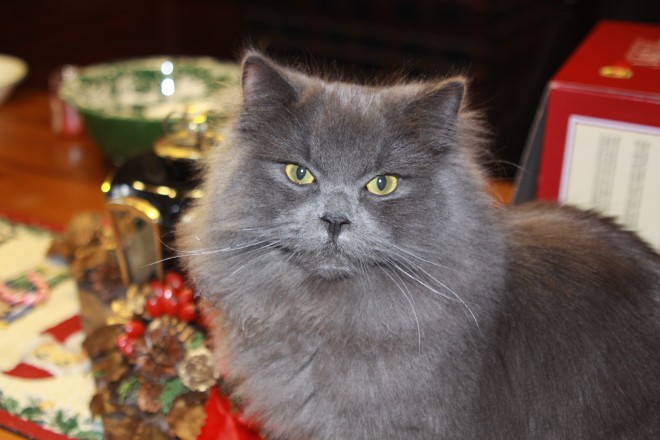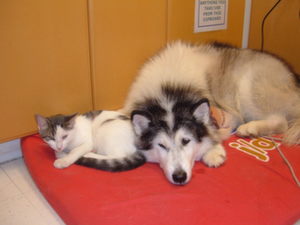
Recently, we had a client come to visit us reporting that their indoor / outdoor cat had started urinating in the home on a curtain, & in one of the bedrooms both on the bed, & in a closet over the past 3 months or so, on a weekly or more regular basis. Many clients are looking for a very rapid, & simple solution to the problem – unfortunately, it’s rarely the case.
Any time an animal urinates in our homes it’s upsetting but, it’s worse for everyone involved if this becomes a semi-regular problem. Before you just attempt cleaning the areas of interest or, using some form of physical barrier, it’s a very good idea to come in for a physical examination to rule out any medical conditions. It is not that unusual for a cat to present with diabetes or, a simple urinary tract infection that causes similar symptoms & an office visit can usually quickly detect these issues.
After medical causes are removed from the equation (sometimes this does involve not only a urinalysis test but also bloodwork); There really only four or five concerns that need to be addressed &, all of them require some thought & change in behavior on both ourselves &, our family in order to change the behavior in our cat.
#1- Litter Box Numbers – There are usually “never enough” litter boxes. The general understanding is that there should be at least one on every floor in the home, AND at least one more than the number of cats in the home. For example, if you have four cats in a three floor home- FIVE litter boxes are needed!, & remember that two litter boxes in the same room do not count as two but only as one to our cats senses.
Aside – Cats Like Privacy! Place the litter pan(s) AWAY from noisy appliances like furnaces, dehumidifiers, washers/dryers, or a frequency used human bathroom whenever possible.
#2- Type of Litter Makes a Difference – Remembering that your cat needs two & 1/2 inches in litter depth, the type of litter does make a difference to many cats. I used clay litter for years with no concerns however, many studies now indicate that cats have a preference for non-scented, clumping cat litter. There are other natural clumping litters available that work well too.
#3- This one’s Simple – Clean your litter box DAILY! If you’re using clumping cat litter change over the entire contents of the litter box if not weekly then, every two weeks. Be certain to clean the litter pans out with warm, soapy water &, dry them well before refilling them. Some recommend replacing the Litter Pan every 6 Months as well as the accumulated odors in plastic cannot be fully removed &, some cats find that repulsive-they do have a sensitive sense of smell after all…
#4- Type / Design of the Litter Box – Some cats prefer completely enclosed litter boxes [as do we usually] however, many cats need open litter boxes – they want to see any other cats in the area to ensure they are not ‘trapped’ by a more alpha cat in the home. Also, consider that very young kittens & very old cats can’t climb over high sided boxes either, so varying the type of litter boxes in the home is always very recommended. Sometimes, it is simpler to cut down one side of a cheap litter box to obtain this result.
#5- STRESS – Once you addressed the previous four issues, changes in their world becomes the most likely “last straw” for many cats. My point is: Many cats will “deal with” dirty litter boxes, not enough litter boxes, possibly a discontent with the type of litter, or the design of the litter box – but stress pushes them to the point that they start to urinate outside the box.
In our client’s case-it was an infestation of fleas &, unfortunately the client did not see this is a significant issue until things had advanced to the degree they did.
Whether your cat is indoors or, does go outdoors – relationships within the ‘clowder’ (Aka. group of cats) you have in your home or, in your neighbourhood do change over time & cats that once got along may no longer do so. Also there may be a new dog in the area or, within the home you may have moved the furniture, obtained new furniture, or it can be simply a new perfume or even in some cases, we have found when clients paint their homes, they suddenly have behavior issues in their cats!
For these situations behavioral training products are one option, as are pheromones, medications, & even sometimes playing music will make a difference if the music is chosen correctly.
In summary although many clients want that simple solution, it rarely exists once a medical concern has been eliminated in your cat where abnormal urination in the home is considered.
Please take the time to review the first four options, & contact your veterinarian in a timely manner for his or her medical opinion on the overall health of your pet & take things from there! If the situation is dealt with earlier – many cats return to their normal behavior quickly, urinating & defecating in the appropriate locations.
Submitted with respect from Dr. Jeff Goodall, Sunnyview Animal Care in Bedford, Nova Scotia, Halifax Veterinarian, Lower Sackville Veterinarian, Fall River Veterinarian, using various Veterinary Reviewed Source materials. Further Reference Information Available upon Request.
Related Tags – Cat Health, Cat Diseases, Feline Urination, Aberrant Urination in Cats, veterinary treatment, veterinary information, cat care, pet care, Litter behaviour, diabetes in cats, urinary infections in cats,
Sunnyview Animal Care
36 Duke Street, Unit#6
Bedford, Nova Scotia B4A 2Z5
Phone: (902)835-2223 Fax:(902)835-8837
sunnyviewvet@eastlink.ca / www.sunnyview.vet





